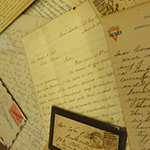 University Library
Sources of Inquiry
University Library
Sources of Inquiry
 University Library
Sources of Inquiry
University Library
Sources of Inquiry
Scrapbooks and photo albums are usually filled with mementos, photographs, clippings, and other pieces of ephemera that are meaningful or significant to their creators. Viewed today, they can provide unique insights into the lives of those who lived before us, telling us of places they traveled, clothing and hairstyles they adopted, cultural practices they engaged in, new technologies they encountered, and more. For practical reasons most items pasted into scrapbooks and photo albums are flat, but some may be folded or nearly flat, like pressed flowers or campaign buttons.
Scrapbooks and photo albums often become fragile more quickly than other kinds of records, because they contain so many different kinds of materials. The paste-ins can tear pages, loosen, or detach completely. Additionally, bindings can sometimes burst if the volume contains too many items. For these reasons we store and use scrapbooks very carefully. Those on display in the case date from the 20th century, and were selected in part because they can be safely displayed for several months.
The case includes a photo album kept by the Booth family, of which famed 19th-century actors Edwin and John Wilkes were members. The other albums were probably created by military service men, including a member of the American Expeditionary Forces in World War I who snapped photographs of early combat aircraft, a Lieutenant in the British Royal Navy stationed at Hong Kong in the early 1920s, and a serviceman who compiled a collection of pro-US propaganda targeted at Japanese civilians during World War II.
Case 7, Correspondence, is the flat case closest to the gallery entrance.
1
ScrapbookEdwin Booth Family Collection
2
Scrapbook, 1941-45Psychological Warfare Branch Scrapbook
3
Photograph Album, 1922-23A Submariner's Album in the Far East
4
Photograph Album, 1918American Expeditionary Forces (AEF) Photograph Album
